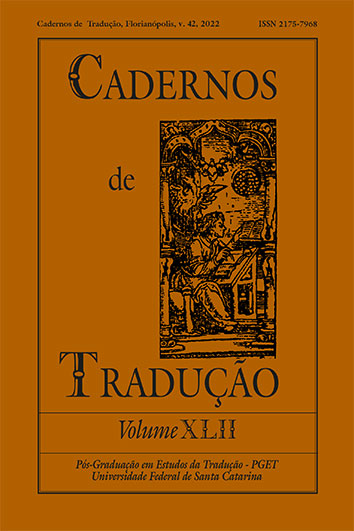Gêneros Discursivos, Diversidade Cultural e Tradução de Textos Turísticos
DOI:
https://doi.org/10.5007/2175-7968.2022.e79074Resumen
A partir do estudo de Cronin (2000) sobre a relação entre língua e tradução no turismo, este artigo explora os diferentes graus de diversidade cultural através de alguns exemplos de tradução intralinguística, uso de palavras estrangeiras em textos monolíngues e tradução interlinguística entre espanhol, inglês e italiano. Na perspectiva da acessibilidade, um modelo dinâmico para a gestão da diversidade cultural no turismo é proposto, baseado nas necessidades comunicativas do turista, que pode incluir diferentes modalidades de tradução. Em particular, será enfatizada a importância de dois passos preliminares: a análise do gênero discursivo ao qual os textos pertencem e a seleção da informação cultural.
Citas
Agorni, Mirella. “Questions of Mediation in the Translation of Tourist Texts” Altre Modernità, [S.I.], feb. (2012): 1-11. 20 jan 2018 http://riviste.unimi.it/index.php/AMonline/article/view/1963/2213
Agorni, Mirella “Tourism Across Languages and Cultures: Accessibility Through Translation” Cultus: The Journal of Intercultural Mediation and Communication n. 9 (2016): 13- 27.
Baider, Fabienne et al., editado por. La communication touristique. Approche discursive de l’identité et l’altérité. L’Harmattan (2004).
Calvi Maria Vittoria. “Los géneros discursivos en la lengua del turismo: una propuesta de clasificación” Ibérica, n. 19 (2010): 9-31.
Calvi Maria Vittoria. “Guía de viaje y turismo 2.0: Los borrosos confines de un género” Ibérica, n. 31 (2016): 15-38.
Calvi Maria Vittoria. “The Language of Tourism in New Travel Guides: Discursive Identities and Narratives” Ways of Seeing, Ways of Being: Representing the Voices of Tourism, editado por Maurizio Gotti et al., Peter Lang (2017) : 25-48.
Cappelli, Gloria. “The translation of tourism-related websites and localization: problems and perspectives” Voices on Translation, RILA Rassegna Italiana di Linguistica Applicata, editado por Annalisa Baicchi, Bulzoni Editore (2008): 97-115.
Cepeda Fuentes, Marina. La Spagna a tavola. Newton Compton (1990).
Cohen, Erik. “Toward a Sociology of International Tourism” Social Research v. 39, n. 1 (1972): 164-182.
Cohen, Erik. “Authenticity and Commoditization in Tourism” Annals of Tourism Research v. 15, n. 3 (1988): 371-386.
Cronin, Michael. Across the Lines. Travel, Language, Translation. Cork University Press (2000).
Dann, Graham M. S. The Language of Tourism. A Sociolinguistic Perspective, CAB International (1996)
Durán Muñoz, Isabel. “Caracterización de la traducción turística: problemas, dificultades y posibles soluciones” Revista de Lingüística y Lenguas Aplicadas, n. 7 (2012): 103-113.
Edo-Marzá, Nuria. “Communication in tourism 2.0: redefining roles, restating ‘the traditional’, reaching the world” Ibérica, n. 31 (2016): 9-14.
España Madrid, Turespaña (2006).
Fuentes Luque, Adrián. editado por. La traducción en el sector turístico. Atrio (2005).
Gandin, Stefania. “Translating the Language of Tourism. A Corpus Based Study on the Translational Tourism English Corpus (T-TourEC)” Procedia: Social & Behavioral Sciences, n. 95 (2013): 325-335.
García Izquierdo, Isabel. “Los géneros y las lenguas de especialidad” Las lenguas profesionales y académicas, editado por Enrique Alcaraz Varó et alii, Ariel (2006): 119-125.
García Izquierdo, Isabel. Competencia textual para la traducción, Tirant lo Blanch (2011)
González Pastor, Diana M. “La traducción como instrumento de mediación intercultural en el ámbito turístico: el papel del traductor” Interculturalidad y traducción en cine, televisión y teatro, editado por Miguel Ángel Candel Mora y Emilio Ortega Arjonilla, Tirant Humanidades (2012): 93-124.
Jaakson, Reiner. “Beyond the tourist bubble? Cruiseship passengers in port” Annals of Tourism Research 31, n. 1 (2004) 44-60.
Katan, David y Cinzia Spinzi, editado por. The Intercultural Question and the Interpreting Professions. Cultus: The Journal of Intercultural Mediation and Communication, v. 9, n. 2, (2016).
Katan, David. “Translating for Outsider Tourists: Cultural Informers Do It Better” Cultus: The Journal of Intercultural Mediation and Communication, n. 9 (2016): 63-90.
Kelly, Dorothy. “The Translation of Texts from the Tourist Sector: Textual Conventions, Cultural Distance, and Other Constraints” Trans, n. 2, (1997): 33-42.
Maingueneau, Dominique. Analyser les textes de communication. Colin (2012).
Mapelli, Giovanna y Javier Santos López. “Estudio comparado de las características discursivas de la guía turística” Viaggiare con la parola, editado por Jordi Canals y Elena Liverani, FrancoAngeli (2010): 89-102.
Morales Miranda, Jorge. Guía Práctica para la interpretación del Patrimonio. El arte de acercar el legado natural y cultural al público visitante. Consejería de Cultura, Junta de Andalucía (1998)
Moreno Paz, María del Carmen. “La traducción de referentes culturales en los textos turísticos: dificultades, estrategias y técnicas de traducción (español-inglés)” Traducción literaria, otras traducciones especializadas y disciplinas afines a la traducción, editado por María del Carmen Camus Camus y Manuel Marcos Aldón, Comares (2017):185-200.
Nobs, Marie Louise. La traducción de folletos turísticos. ¿Qué calidad demandan los turistas? Comares (2006).
Palusci, Oriana y Sabrina Francesconi, editado por. Translating Tourism Linguistic/cultural Representations. Editrice Università degli Studi di Trento (2006).
Relinque Barranca, Mariana. “La traducción hacia el inglés de las señales turísticas de Sevilla: problemas y consecuencias para el turismo” Sendebar, n. 29 (2018): 277-303.
Sánchez Jiménez, David. “Revisión crítica del concepto de género en el discurso escrito y su aplicación didáctica a la enseñanza de las lenguas con propósitos específicos” Estudios de lingüística aplicada v. 34, n. 64 (2016): 207-236.
Sanmartín Sáez, Julia. “A propósito de los ‘cibergéneros’: el portal oficial de turismo de España ‘spain.info’ y el facebook institucional ‘see spain’ como objeto de análisis” Lingüística Española Actual, n. 36 (2014): 5-34.
Santulli, Francesca. “Il discorso procedurale come tratto distintivo della guida turistica” Linguistica. Linguaggi specialistici. Didattica delle lingue, editado por Guliana Garzone y Rita Salvi, CISU (2007): 227-240.
Savelli, Asterio. Sociologia del turismo. Hoepli (2012).
Shiro Martha et al. Los géneros discursivos desde múltiples perspectivas: teorías y análisis. Iberoamericana/Vervuert (2012).
Soto Almela, Jorge. “La traducción de términos culturales en el contexto turístico español-inglés: recepción real en usuarios anglófonos” Quaderns: revista de traducción n. 20 (2013): 235-250.
Soto Almela, Jorge. “La recepción de elementos culturales traducidos presentes en folletos turísticos digitales: un estudio empírico con turistas anglófonos” El léxico del discurso turístico 2.0, editado por Mercedes López Santiago y David Giménez Folqués, IULMA Monographs (2016): 37-59.
Suau-Jiménez, Francisca. “El género y el registro en la traducción del discurso profesional: Un enfoque funcional aplicable a cualquier lengua de especialidad” Culturele (2001). 13 nov. 2018 http://roderic.uv.es/handle/10550/31179.
Suau-Jiménez, Francisca. “Traducción de calidad de webs hoteleras: discurso interpersonal e implicación del cliente” Onomázein, n. 32 (2015): 152-170.
Suau-Jiménez Francisca e Laura Ramírez Polo. “La traducción estratégica de páginas web de hoteles: un elemento necesario para la persuasión del cliente” I Congreso Internacional de Traducción Económica, Comercial, Financiera e Institucional (2014). 18 jan 2018 https://dti.ua.es/es/comenego/congreso-traduccion-economica/programa.html.
Urry, John. The Tourist Gaze. Sage (1990)
Venuti, Lawrence. The Translator’s Invisibility: A History of Translation. Routledge (1995).
Descargas
Publicado
Cómo citar
Número
Sección
Licencia
Derechos de autor 2022 Cadernos de Tradução

Esta obra está bajo una licencia internacional Creative Commons Atribución 4.0.
Declaración de Derecho de Autor
Los autores conservan sus derechos de autor y conceden a la revista el derecho a la primera publicación bajo la Licencia Creative Commons Attribution, que permite que se comparta el trabajo reconociéndose la autoría y publicación inicial en esta revista.
Los autores están autorizados a asumir contratos adicionales por separado para la distribución no exclusiva de la versión del trabajo publicada en esta revista (por ej.: publicar en un repositorio institucional o como capítulo de libro, reconociéndose la autoría y publicación inicial en esta revista).





















































